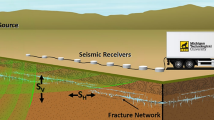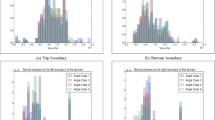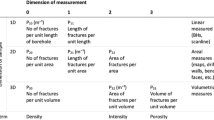Abstract
Accurate discrete fracture network modeling is a significant requirement for fluid flow simulation in various applications such as managing groundwater resources, simulating oil and gas reservoirs, and modeling geothermal energy resources. The existing fracture network modeling approaches are often unsuccessful in regenerating spatial variability and can only characterize the fracture geometries by statistical probability distributions. In addition, the alternative geostatistical methods to address these limitations suffer from a smoothing effect and reproducing fracture patterns due to the use of the two-point statistics technique. In this paper, a comparative study between the new object-based iterative fracture network modeling algorithm and the geostatistical direct sampling (DS) method is performed. The presented algorithm starts with an initial configuration to directly model the statistical geometry of the fracture network and uses particle swarm optimization algorithm to impose four different constraints and include its spatial variability. Each constraint is defined in the form of the difference between spatial properties of the reference configuration and of the generated model using L2-norm criterion characterized by common specific filtering functions in the image processing. Both employed methods are applied on a real 2-Dimentional fracture network image from an exposed wall and their performance is assessed by four different criteria including classification correctness rate (CCR), indicator variogram (\(\gamma\)), degree of consistency (r), and average relative error (ARE). Results show the superiority of the presented algorithm over the DS method in regenerating the real fracture network configuration with CCR = 0.99, r = 0.994, ARE = 2.63, and the same indicator variogram function.

















Similar content being viewed by others
References
Abido MA (2009) Multiobjective particle swarm optimization technique for environmental/economic dispatch problem. Electric Power Syst Res 79(7):1105–1113. https://doi.org/10.1016/j.epsr.2009.02.005
Agar S, Geiger S (2015) Fundamental controls on fluid flow in carbonates: current workflows to emerging technologies. Geol Soc Lond Spec Publ 406(1):1–59. https://doi.org/10.1144/SP406.18
Amanbek Y, Merembayev T, Srinivasan S (2020) Framework of fracture network modeling using conditioned data with sequential gaussian simulation. arXiv preprint arXiv:2003.01327
Arumugam MS, Rao MVC (2006) On the performance of the particle swarm optimization algorithm with various inertia weight variants for computing optimal control of a class of hybrid systems. Discrete Dyn Nat Soc. https://doi.org/10.1155/DDNS/2006/79295
Baecher GB (1983) Statistical analysis of rock mass fracturing. J Int Assoc Math Geol 15:329–348. https://doi.org/10.1007/BF01036074
Bonnet E, Bour O, Odling NE, Davy P, Main I, Cowie P (2001) Scaling of fracture systems in geological media. J Geophys Res 39:347–383. https://doi.org/10.1029/1999RG000074
Cao T, Xiao A, Wu L, Mao L (2017) Automatic fracture detection based on Terrestrial Laser Scanning data: a new method and case study. Comput Geosci 106:209–216. https://doi.org/10.1016/j.cageo.2017.04.003
Clerc M (2010) From theory to practice in particle swarm optimization. In: Panigrahi BK, Shi Y, Lim MH (eds) Handbook of swarm intelligence. Springer, Berlin, pp 3–36. https://doi.org/10.1007/978-3-642-17390-5_1
Davy P (1993) On the frequency-length distribution of the San Andreas Fault System. J Geophys Res 98(B7):12141–12151. https://doi.org/10.1029/93JB00372
Devlin S, Gnanadesikan R, Kettenring JR (1975) Robust estimation and outlier detection with correlation coefficients. Biometrika 62(3):531–545. https://doi.org/10.1093/biomet/62.3.531
Dutler N, Valley B, Gischig V, Villiger L, Krietsch H, Doetsch J, Brixel B, Jalali M, Amann F (2019) Hydraulic fracture propagation in a heterogeneous stress field. Solid Earth 10:1877–1904. https://doi.org/10.5194/se-10-1877-2019
Einstein HH, Baecher GB (1983) Probabilistic and statistical methods in engineering geology. Rock Mech Rock Eng 16:39–72. https://doi.org/10.1007/BF01030217
Frykmanm P, Srivastava M, Jensen M (2005) Geostatistical simulation of discrete fracture network. In: Annual Conference of the International Association for Mathematical Geology, IAMG, vol 1, pp 664–669
Gläser D, Rainer H, Bernd F, Holger C (2017) A discrete fracture model for two-phase flow in fractured porous media. Adv Water Resour 110:335–348. https://doi.org/10.1016/j.advwatres.2017.10.031
Golub G, Van Loan CF (1996) Matrix computations, 3rd edn. The Johns Hopkins University Press, Baltimore (ISBN 0-8018-5413-X. ISBN-13: 978-0801854149)
Hart BS (2006) Seismic expression of fracture-swarm sweet spots Upper Cretaceous Tight-Gas Reservoirs, San Juan Basin. Am Assoc Pet Geol 90:1519–1534. https://doi.org/10.1306/05020605171
Journel AG, Ying Z (2001) The theoretical links between sequential Gaussian simulation, Gaussian truncated simulation, and probability field simulation. Math Geol 33:31–40. https://doi.org/10.1023/A:1007558125766
Kennedy J, Eberhart R (1995) Particle swarm optimization. In: Proceedings of ICNN'95. International conference on neural networks, vol 4, pp 1942–1948. https://doi.org/10.1109/ICNN.1995.488968
Kulatilake PHSW, Wu TH (1984) Estimation of mean trace length of discontinuities. Rock Mech Rock Eng 17(4):215–232. https://doi.org/10.1007/BF01032335
Lacazette A (2009) Paleostress analysis from image logs using pinnate joints as slip indicators. Am Assoc Pet Geol 93(11):1489–1501. https://doi.org/10.1306/08110909087
Lamarchea J, Lavenu PC, Gauthier BDM, Guglielmi Y, Jayet O (2012) Relationships between fracture patterns, geodynamics and mechanical stratigraphyin Carbonates (South-East Basin, France). Tectonophysics 581:231–245. https://doi.org/10.1016/j.tecto.2012.06.042
Lavoine E, Davy PH, Darcel C, Munier R (2020) A discrete fracture network model with stress-driven nucleation: impact on clustering connectivity, and topology. Front Phys. https://doi.org/10.3389/fphy.2020.00009 (ISSN: 2296-424X)
Lei Q, Latham JP, Tsang ChF (2017) The use of discrete fracture networks for modeling coupled geomechanical and hydrological behaviour of fractured rocks. Comput Geotech 85:151–176. https://doi.org/10.1016/j.compgeo.2016.12.024
Lohr T, Krawczyk CM, Tanner DC, Samiee R, Endres H, Thierer PO, Oncken O, Trappe H, Bachmann R, Kukla PA (2008) Prediction of sub seismic faults and fractures: integration of three-dimensional seismic data, three-dimensional retrode. Am Assoc Pet Geol 92(4):473–485. https://doi.org/10.1306/11260707046
Mahmoodpour S, Masihi M (2016) An improved simulated annealing algorithm in fracture network modeling. J Nat Gas Sci Eng 33:538–550. https://doi.org/10.1016/j.jngse.2016.05.056
Maleki M, Emery X, Mery N (2017) Indicator variograms as an aid for geological interpretation and modeling of ore deposits. Minerals 7(12):241. https://doi.org/10.3390/min7120241
Mariethoz G, Renard P, Straubhaar J (2010) The Direct Sampling method to perform multiple-point geostatistical simulations. Water Resour Res 46(11):1–14. https://doi.org/10.1029/2008WR007621
Masaferro JL, Bulnes M, Poblet J, Casson N (2003) Kinematic evolution and fracture prediction of the Valle Morado structure inferred from 3-D seismic data, Salta province, northwest Argentina. Am Assoc Pet Geol 87(7):1083–1104. https://doi.org/10.1306/02070301102
Masihi M, King PR (2007) A correlated fracture network: modeling and percolation properties. Water Resour Res 43(07):439. https://doi.org/10.1029/2006WR005331
Pan D, Li S, Zhenhao X, Yichi Z, Peng L, Haiyan L (2019) A deterministic-stochastic identification and modelling method of discrete fracture networks using laser scanning: Development and case study. Eng Geol 262:105310. https://doi.org/10.1016/j.enggeo.2019.105310
Pino DS, Bertolo R, Lojkasek-Lima P, Fernandes AJ, Parker B, Hirata R (2021) Discrete fracture network characterization using multiple, high-resolution borehole methods in a crystalline rock aquifer in tropical Sao Paulo city, Brazil. J S Am Earth Sci 105(3):102911. https://doi.org/10.1016/j.jsames.2020.102911
Priest SD, Hudson JA (1981) Estimation of discontinuity spacing and trace length using scanline surveys. Int J Rock Mech Min Sci Geomech Abstr 18:183–197
Prioul R, Jocker J (2009) Fracture characterization at multiple scales using borehole images, sonic logs, and walkaround vertical seismic profile. Am Assoc Pet Geol 93(11):1503–1516. https://doi.org/10.1306/08250909019
Rives T, Razack M, Petit JP, Rawnsley KD (1992) Joint spacing: analogue and numerical simulations. J Struct Geol 14:925–937. https://doi.org/10.1016/0191-8141(92)90024-Q
Rzonca B (2008) Carbonate aquifers with hydraulically non-active matrix: a case study from Poland. J Hydrol 355(1–4):202–213. https://doi.org/10.1016/j.jhydrol.2008.03.021
Shah S, Møyner O, Tenea M, Lie K, Hajibeygi H (2016) The multiscale restriction smoothed basis method for fractured porous media (F-MsRSB). J Comput Phys 318:36–57. https://doi.org/10.1016/j.jcp.2016.05.001
Shakiba S, Asghari O, Khah NK, Zabihi SS, Tokhmechi B (2015) Fault and non-fault areas detection based on seismic data through min/max autocorrelation factors and fuzzy classification. J Nat Gas Sci Eng 26:51–60. https://doi.org/10.1016/j.jngse.2015.05.024
Smeraglia L, Mercuri M, Tavani S, Antonio P, Kettermann M, Billi M, Eugenio C (2021) 3D Discrete Fracture Network (DFN) models of damage zone fluid corridors within a reservoir-scale normal fault in carbonates: Multiscale approach using field data and UAV imagery. Mar Pet Geol 126:104902. https://doi.org/10.1016/j.marpetgeo.2021.104902
Somogyvári M, Jalali MR, Parras SJ, Bayer P (2017) Synthetic fracture network characterization with transdimensional inversion. Water Resour Res 35:5104–5123. https://doi.org/10.1002/2016WR020293
Su N, Zou L, Shen X, Guo F, Ren Y, Xie Y, Li J, Wu J (2014) Fracture patterns in successive folding in the western Sichuan basin, China. J Asian Earth Sci 81:65–76. https://doi.org/10.1016/j.jseaes.2013.12.003
Tharwat A (2021) Classification assessment methods. Appl Comput Inf 17(1):168–192. https://doi.org/10.1016/j.aci.2018.08.003
Tran NH, Chen Z, Rahman SS (2006) Practical application of hybrid modeling to naturally fractured reservoirs. Pet Sci Technol 25(10):1263–1277. https://doi.org/10.1080/10916460500423445
Wang CJ, Vecchiarelli A (2019) A geostatistical approach to modelling dfn: a block size perspective. Rock Mechanics/Geomechanics Symposium, New York City, New York
Wang X, Jardani A, Jourde H, Lonergan L, Cosgrove J, Gosselin O, Massonnat G (2016) Characterisation of the transmissivity field of a fractured and karstic aquifer, southern France. Adv Water Resour 87:106–121. https://doi.org/10.1016/j.advwatres.2015.10.014
Watkins H, Butler RWH, Bond CE, Healy D (2015) Influence of structural position on fracture networks in the Torridon Group, Achnashellach fold and thrust belt, NW Scotland. J Struct Geol 74:64–80. https://doi.org/10.1016/j.jsg.2015.03.001
Zhang F, Damjanac B, Maxwell S (2019) Investigating hydraulic fracturing complexity in naturally fractured rock masses using fully coupled multiscale numerical modeling. Rock Mech Rock Eng 52(12):5137–5160. https://doi.org/10.1007/s00603-019-01851-3
Funding
The authors declare that no funds, grants, or other support were received during the preparation of this manuscript.
Author information
Authors and Affiliations
Contributions
Both authors contributed to the study's conception and design. Material preparation, data collection, and analysis were performed by Sima Shakiba. The first draft of the manuscript was written by Sima Shakiba and the second author commented on previous versions of the manuscript. Both authors read and approved the final manuscript.
Corresponding author
Ethics declarations
Conflict of interest
The authors have no relevant financial or non-financial interests to disclose.
Additional information
Publisher's Note
Springer Nature remains neutral with regard to jurisdictional claims in published maps and institutional affiliations.
Rights and permissions
Springer Nature or its licensor holds exclusive rights to this article under a publishing agreement with the author(s) or other rightsholder(s); author self-archiving of the accepted manuscript version of this article is solely governed by the terms of such publishing agreement and applicable law.
About this article
Cite this article
Shakiba, S., Doulati Ardejani, F. A comparative study of novel object-based geostatistical algorithm and direct sampling method on fracture network modeling. Stoch Environ Res Risk Assess 37, 777–793 (2023). https://doi.org/10.1007/s00477-022-02320-0
Accepted:
Published:
Issue Date:
DOI: https://doi.org/10.1007/s00477-022-02320-0




